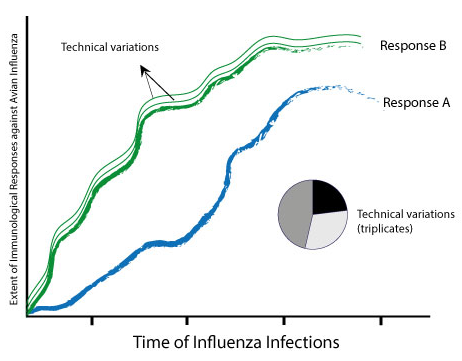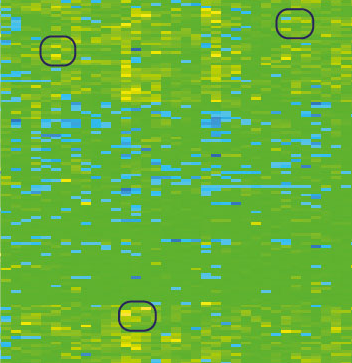Advances in Animal and Veterinary Sciences
Commentary
Understanding Animal Disease Dynamics and Developing Synchronized Vaccination through Veterinary Precision Medicine
Muhammad Munir
The Pirbright Institute, Ash Road, Pirbright, Woking, GU24 0NF, United Kingdom.
Abstract | Innovative panomics and biological approaches have advanced our understanding on the disease dynamics and pathobiology of microbes. Orchestrating genetic, evolutionary, and phenotypic variability in the context of “molecules-cells-organs-organism” can revolutionize and synchronize therapies in livestock and poultry. Novel discipline, precision medicine, has recently gained attention in human disease dynamics and hold tremendous potential for future research in model animals. Cumulative knowledge of contemporary veterinary precision medicine would help to advance not only livestock health but would also facilitate rationalization of studying medical pathogens and drugs validation.
Keywords | Vaccines, Precision medicine, Veterinary, Variability, Effectiveness
Editor | Kuldeep Dhama, Indian Veterinary Research Institute, Uttar Pradesh, India.
Received | August 05, 2015; Revised | August 08, 2015; Accepted | August 08, 2015; Published | October 02, 2015
*Correspondence | Muhammad Munir, The Pirbright Institute, Pirbright, Woking, United Kingdom; Email: drmunir.muhammad@gmail.com
Citation | Munir M (2015). Understanding animal disease dynamics and developing synchronized vaccination through veterinary precision medicine. Adv. Anim. Vet. Sci. 3(11): 574-576.
DOI | http://dx.doi.org/10.14737/journal.aavs/2015/3.11.574.576
ISSN (Online) | 2307-8316; ISSN (Print) | 2309-3331
Copyright © 2015 Munir. This is an open access article distributed under the Creative Commons Attribution License, which permits unrestricted use, distribution, and reproduction in any medium, provided the original work is properly cited.
Introduction
Every individual animal is diverse and distinct both within and across species and breed levels, and this diversity encompasses from their molecular and cellular composition to their responses against pathogens. This fact explains the unsynchronized correlates of vaccination responses, and sources of immune-state variability. The “Precision Medicine” addresses the panomic analysis and system biological approaches to underpin the genetic and phenotypic variations and their exploitation to assess the efficiency of a specific treatment or immunization. This emerging discipline has recently been started in human medicine and gained both scientific and media attentions. However, its applications and foreseeing have not been proposed for veterinary medicine. While animals are frequently and reliably are being used in research and drugs validation, it is worth initiating the understanding of precision medicine in model animals and its extension to the livestock and poultry. In this commentary, I highlight recent developments in this emerging field and our current understanding on the available data in the veterinary precision medicine.
Messages in Noise: Exploring the Omics Data for Precision Medicine
With the advancement of current technologies such as MinION by Oxford Nanopore (Bayley, 2015) and recently invented “Gene Expression in a Drop” (Klein et al., 2015), generation of the gigantic genetic information has not only been revolutionized but also has become cheaper, accessible and affordable. On one hand machine-driven data is abundant, on the other hands the tools required to unlock the messages has lagged behind in several aspects. Comparative global gene expression within same experimental settings display biological variations indicating the importance of fine-tuned and advanced tools to not only catch these messages from huge datasets but also to conveniently interpret and link to individuals (Figure 1). Certainly, a cloud-base accumulation and universal access to this data in future would leave an open option to pinpoint the hidden messages and their exploitation in the benefit of mankind and veterinary medicine.
Variability in Active Immunization: What to find for Precision Medicine?
The eventual aim of vaccination, through administration of diverse kind of vaccines, is to induce an enough level of antibodies against subject-specific antigen that could protect animals from invading pathogens (Tsang, 2015). While the responses to vaccination are determined at different time points, using different methodologies and interest-specific interpretation, an efficient protection should co-relate at
Circles indicate the variability between three replicates, and the potential to explore the hidden meaning in this variability
least independent of time points. However, this is usually not the case especially when other contributing factors are to be considered. The extent of technical and biological variations is fundamental and crucial to estimate the reliability and applicability of vaccination regimes (Figure 2). In this regard, correlates and predictors of immune responses might be individual animal-specific. This specificity could possible lead to the failure of vaccine success in the field conditions. For instances, the expression of interferon-regulated-genes in avian species is differentially regulated in males compared to females of similar genetic background. This gender-specific expression is linked to the association of the interferons (at least Type I IFNs) to the sex chromosome. While interferons and interferon-regulated genes are central to vaccine induced protection, failure to consider the gender in the correlates of protection might lead to misleading interpretations.
These intrinsic factors, correlates and predictors of potent immunisation may not completely account for the immunisation, the inter-species or inter-breed variations could also be due to pre-existing immunity. While most of experimental studies monitor the pre-existing subject-specific immunity, however, it remained unclear and unexplainable the primed adaptive and innate immunity or the immunity induced by the cross-protection. Thought, it is matter of comprehensiveness of the pre-existing immunity, it is worth considering the marker of immunity. For instance, the effector memory for the CD4+ T cell subsets negatively co-relates with primed pathogens and the cross-neutralization of the micro-sera with all possible related antigens. However, extensive research is needed to identify an explicit marker of primed individuals and the markers that are exclusive to that particular pathogen/stimulus.

Figure 2:A model for individual and technical variability in immunological responses against influenza viruses
Genetic Bases of Individual Variability-An Established Bases for Precision Medicine
Exploring extensive datasets, based on microarray, high throughput sequencing and metadata sets, it is evident that there are individual-specific SNPs and genetic variations that could correlate to the variability in immunological induction and responses to pathogens (Ananthakrishnan et al., 2015). Such factors are excellent biomarker to predict biological status of the individuals. What factors and forces drive heritability and genetic variations are not clearly known in any living being.
Current Hurdles in Veterinary Precision Medicine
There are several outstanding barriers to remove in order to excel in the field of veterinary precision medicine. Undoubtedly, establishment of unified and globally acceptable experimental regimes are required to reduce technical variability, facilitate reproducibility and re-exploring possibilities of the data wherever and whenever needed. One of the major barriers is to assess the state of individual cells in terms of their proteomics, transcritomics, metabolomics and epigenetics. With the development of droplet-based high throughput sequencing methodologies (Klein, et al., 2015), this individual cell level information will be phenomenal in understanding the variability within cell populations. The cumulative data would help to mitigate future studies and robust biological insights.
CONCLUSIONS
Increased resolution, effectiveness and scalability in latest and emerging technologies would yield meaningful biological datasets, integrative computational methodologies and correlates of disease dynamics and vaccine responses. The cumulative gained information can then be exploited in empowering better vaccine design and efficacy. Owing to extensive use of vaccines in livestock and poultry, these precisions and advancements are urgently needed in veterinary medicine to rationalize the immunization in animals.
CONFLICT OF INTEREST
There exists not any conflict of interest.
References






